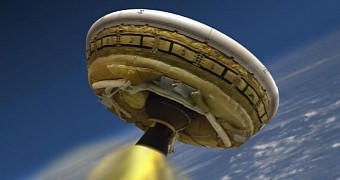Sending crews of astronauts all the way to Mars or some other nearby planet is pretty much futile if there is no way to safely have them land on their target orb's surface.
NASA's Spirit and Opportunity robotic explorers were simply allowed to crash on the Red Planet. True, they were fitted with airbags to make the impact a tad smoother and protect them, but it's safe to assume that the rovers didn't exactly have the time of their life.
As for the space agency's Curiosity rover, it had a hovering vehicle deliver it as close as possible to Mars' surface. Then, it too was simply dropped on the Red Planet.
Now, you can't really catapult astronauts onto Mars. Not if you want them to make it on the surface of this planet with all the bones and organs inside their body in perfect condition and fully functional.
This is where NASA's Low-Density Supersonic Decelerator comes in. This space vehicle, basically a flying saucer outfitted with a donut-like inflatable balloon, is designed to create drag and thus considerably slow a spacecraft, helping it make a smooth landing.
Next week, the flying saucer will be put to the test
Earlier this year, on March 31, space agency NASA showed us its latest Low-Density Supersonic Decelerator, weighing in at about 7,000 pounds (3,175 kilograms) casually spinning atop a table at the Jet Propulsion Laboratory in Pasadena, California.
This experiment was carried out to test the space vehicle's balance in preparation for a proper flight test scheduled for next week. Thus, NASA says that, come June 2, it wants to send the craft into space.
The donut-shaped flying saucer will launch from a US Navy base in Hawaii. Having reached the desired altitude, it will simply be allowed to fall back to Earth. This space adventure will test its abilities to safely deliver astronauts and cargo to Mars.
“The test, performed over the Pacific Ocean, will simulate the supersonic entry and descent speeds at which the spacecraft would be traveling through the Martian atmosphere,” NASA explains.
Mission scientists promise to detail this latest flight test of the Low-Density Supersonic Decelerator in a briefing scheduled for June 1, so keep an eye on this page for updates.

 14 DAY TRIAL //
14 DAY TRIAL //